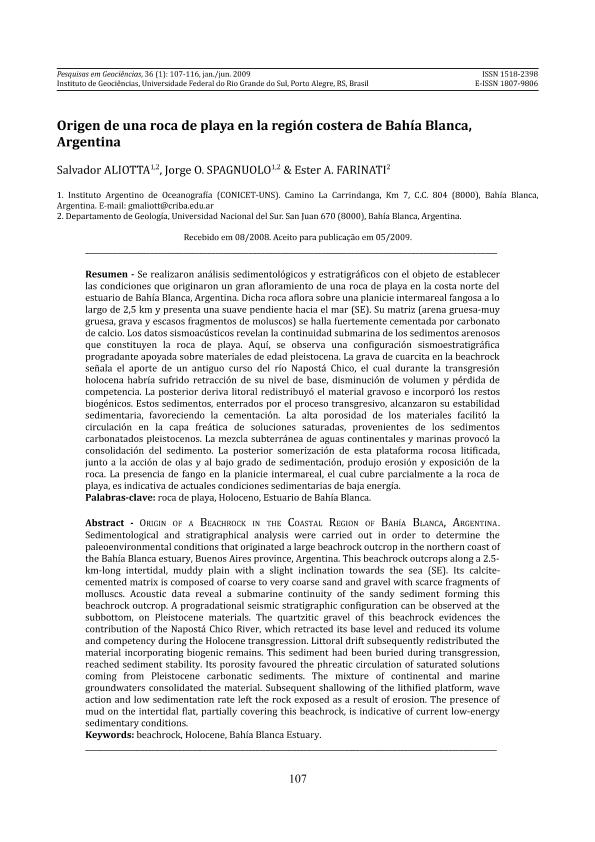Artículo
Se realizaron análisis sedimentológicos y estratigráficos con el objeto de establecer las condiciones que originaron un gran afloramiento de una roca de playa en la costa norte del estuario de Bahía Blanca, Argentina. Dicha roca aflora sobre una planicie intermareal fangosa a lo largo de 2,5 km y presenta una suave pendiente hacia el mar (SE). Su matriz (arena gruesa-muy gruesa, grava y escasos fragmentos de moluscos) se halla fuertemente cementada por carbonato de calcio. Los datos sismoacústicos revelan la continuidad submarina de los sedimentos arenosos que constituyen la roca de playa. Aquí, se observa una configuración sismoestratigráfica progradante apoyada sobre materiales de edad pleistocena. La grava de cuarcita en la beachrock señala el aporte de un antiguo curso del río Napostá Chico, el cual durante la transgresión holocena habría sufrido retracción de su nivel de base, disminución de volumen y pérdida de competencia. La posterior deriva litoral redistribuyó el material gravoso e incorporó los restos biogénicos. Estos sedimentos, enterrados por el proceso transgresivo, alcanzaron su estabilidad sedimentaria, favoreciendo la cementación. La alta porosidad de los materiales facilitó la circulación en la capa freática de soluciones saturadas, provenientes de los sedimentos carbonatados pleistocenos. La mezcla subterránea de aguas continentales y marinas provocó la consolidación del sedimento. La posterior somerización de esta plataforma rocosa litificada, junto a la acción de olas y al bajo grado de sedimentación, produjo erosión y exposición de la roca. La presencia de fango en la planicie intermareal, el cual cubre parcialmente a la roca de playa, es indicativa de actuales condiciones sedimentarias de baja energía. Sedimentological and stratigraphical analysis were carried out in order to determine the paleoenvironmental conditions that originated a large beachrock outcrop in the northern coast of the Bahía Blanca estuary, Buenos Aires province, Argentina. This beachrock outcrops along a 2.5- km-long intertidal, muddy plain with a slight inclination towards the sea (SE). Its calcitecemented matrix is composed of coarse to very coarse sand and gravel with scarce fragments of molluscs. Acoustic data reveal a submarine continuity of the sandy sediment forming this beachrock outcrop. A progradational seismic stratigraphic configuration can be observed at the subbottom, on Pleistocene materials. The quartzitic gravel of this beachrock evidences the contribution of the Napostá Chico River, which retracted its base level and reduced its volume and competency during the Holocene transgression. Littoral drift subsequently redistributed the material incorporating biogenic remains. This sediment had been buried during transgression, reached sediment stability. Its porosity favoured the phreatic circulation of saturated solutions coming from Pleistocene carbonatic sediments. The mixture of continental and marine groundwaters consolidated the material. Subsequent shallowing of the lithified platform, wave action and low sedimentation rate left the rock exposed as a result of erosion. The presence of mud on the intertidal flat, partially covering this beachrock, is indicative of current low-energy sedimentary conditions.
Origen de una roca de playa en la región costera de Bahía Blanca, Argentina
Título:
Origin of a beachrock in the coastal region of Bahía Blanca, Argentina
Fecha de publicación:
05/2009
Editorial:
Universidade Federal do Rio Grande do Sul. Instituto de Geociências
Revista:
Pesquisas Em Geociencias
ISSN:
1518-2398
e-ISSN:
1807-9806
Idioma:
Español
Tipo de recurso:
Artículo publicado
Clasificación temática:
Resumen
Palabras clave:
BAHÍA BLANCA ESTUARY
,
BEACHROCK
,
HOLOCENE
Archivos asociados
Licencia
Identificadores
Colecciones
Articulos(IADO)
Articulos de INST.ARG.DE OCEANOGRAFIA (I)
Articulos de INST.ARG.DE OCEANOGRAFIA (I)
Citación
Aliotta, Salvador; Spagnuolo, Jorge Osvaldo; Farinati, Ester Amanda; Origen de una roca de playa en la región costera de Bahía Blanca, Argentina; Universidade Federal do Rio Grande do Sul. Instituto de Geociências; Pesquisas Em Geociencias; 36; 1; 5-2009; 107-116
Compartir
Altmétricas




